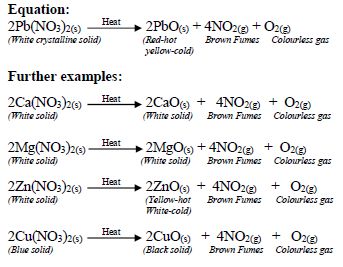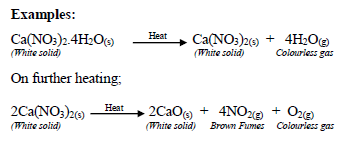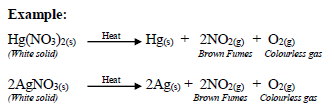- All nitrates except ammonium nitrate decompose on heating to produce oxygen gas as one of the products.
- Nitrates can be categorized into 4 categories based on the products formed when they are heated.
- The ease with which nitrates decompose increases down the electrochemical series of metals.
1. Nitrates of metals higher in the electrochemical series like sodium and potassium decompose on heating to give the corresponding metal nitrite and oxygen.

2. Nitrates of most other metals (heavy metals) that are average in the electrochemical series decompose on heating to give the metals oxide; nitrogen (IV) oxide and oxygen gas.
Example: action of heat on lead (II) nitrate.
(i). Procedure:
- Solid white lead (II) nitrate crystals are strongly heated in a boiling (ignition) tube.
- Products are passed into a U- tube immerse in ice.
- Excess gases are channeled out to a fume chamber.
(ii). Observations:
- The white crystalline solid decrepitates.
- A colourless gas (oxygen) is liberated and immediately followed by a red brown fumes/ gas (nitrogen (IV) oxide).
- A pale yellow liquid (dinitrogen tetroxide) condenses in the U-tube in the ice cubes.
- This is due to condensation of nitrogen (IV) oxide.
- A residue which is red when hot and yellow on cooling remains in the boiling (ignition) tube

Note:
- Some nitrates are hydrated and when heated first give out their water of crystallization; and then proceed to as usual on further heating.

3. Nitrates of metals lower in the reactivity series e.g. mercury and silver decompose on heating to give the metal, nitrogen (IV) oxide and oxygen.

4. Ammonium nitrate decomposes to nitrogen (I) oxide and water vapour.

Note:
This reaction is potentially dangerous as ammonium nitrate explodes on strong heating.
Kavungya answered the question on
March 5, 2019 at 09:46